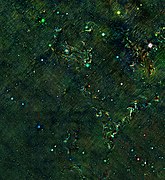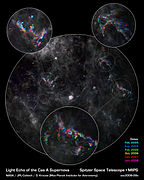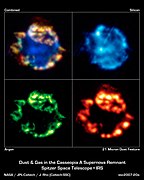Cassiopeia A
SN 1604 | |
| Followed by | G1.9+0.3 (unobserved, c. 1868), SN 1885A (next observed) |
|---|---|
| | |
| ] | |
Cassiopeia A (Cas A) (ⓘ) is a supernova remnant (SNR) in the constellation Cassiopeia and the brightest extrasolar radio source in the sky at frequencies above 1 GHz. The supernova occurred approximately 11,000 light-years (3.4 kpc) away within the Milky Way;[2][3] given the width of the Orion Arm, it lies in the next-nearest arm outwards, the Perseus Arm, about 30 degrees from the Galactic anticenter. The expanding cloud of material left over from the supernova now appears approximately 10 light-years (3 pc) across from Earth's perspective. It has been seen in wavelengths of visible light with amateur telescopes down to 234 mm (9.25 in) with filters.[4]
It is estimated that light from the supernova itself first reached
Cas A was among the first discrete astronomical radio sources found. Its discovery was reported in 1948 by Martin Ryle and Francis Graham-Smith, astronomers at Cambridge, based on observations with the Long Michelson Interferometer.[5] The optical component was first identified in 1950.[6]
Possible observations
Calculations working back from the currently observed expansion point to an explosion that would have become visible on Earth around 1667. Astronomer William Ashworth and others have suggested that the Astronomer Royal John Flamsteed may have inadvertently observed the supernova on 16 August [O.S. 6 August] 1680, when he catalogued a sixth-magnitude star 3 Cassiopeiae, but there is no corresponding star at the recorded position. Possible explanations include an error in the position,[7] or that a transient was recorded. Caroline Herschel noted that a star in the vicinity of τ Cas, HD 220562, fit well with 3 Cas if a common error in sextant readings was made.[8] Alternatively, the star AR Cassiopeiae may have been observed, again with the position recorded incorrectly. The position and timing mean that it may have been an observation of the Cassiopeia A progenitor supernova.[9] Another suggestion from recent cross-disciplinary research is that the supernova was the "noon day star", observed in 1630, that was thought to have heralded the birth of Charles II, the future monarch of Great Britain.[10] At any rate, no supernova occurring within the Milky Way has been visible to the naked eye from Earth since.
Expansion
The expansion shell has a temperature of around 30 million K, and is expanding at 4000−6000 km/s.[2]
Observations of the exploded star through the Hubble Space Telescope have shown that, despite the original belief that the remnants were expanding in a uniform manner, there are high velocity outlying eject knots moving with transverse velocities of 5,500−14,500 km/s with the highest speeds occurring in two nearly opposing jets.[2] When the view of the expanding star uses colors to differentiate materials of different chemical compositions, it shows that similar materials often remain gathered together in the remnants of the explosion.[3]
Radio source
Cas A had a flux density of 2720 ± 50 Jy at 1 GHz in 1980.[11] Because the supernova remnant is cooling, its flux density is decreasing. At 1 GHz, its flux density is decreasing at a rate of 0.97 ± 0.04 percent per year.[11] This decrease means that, at frequencies below 1 GHz, Cas A is now less intense than Cygnus A. Cas A is still the brightest extrasolar radio source in the sky at frequencies above 1 GHz.
X-ray source
Although Cas X-1 (or Cas XR-1), the apparent first X-ray source in the constellation Cassiopeia was not detected during the 16 June 1964, Aerobee sounding rocket flight, it was considered as a possible source.[12] Cas A was scanned during another Aerobee rocket flight of 1 October 1964, but no significant X-ray flux above background was associated with the position.[13] Cas XR-1 was discovered by an Aerobee rocket flight on 25 April 1965,[14] at RA 23h 21m Dec +58° 30′.[15] Cas X-1 is Cas A, a Type II SNR at RA 23h 18m Dec +58° 30′.[16] The designations Cassiopeia X-1, Cas XR-1, Cas X-1 are no longer used, but the X-ray source is Cas A (SNR G111.7-02.1) at 2U 2321+58.
In 1999, the
Supernova reflected echo
In 2005 an infrared echo of the Cassiopeia A explosion was observed on nearby gas clouds using
Phosphorus detection
In 2013, astronomers detected phosphorus in Cassiopeia A, which confirmed that this element is produced in supernovae through supernova nucleosynthesis. The phosphorus-to-iron ratio in material from the supernova remnant could be up to 100 times higher than in the Milky Way in general.[22]
Gallery
-
Cassiopeia A infrared echo as seen by unWISE. The observation time in this image ranges from 2015 (red) to 2020 (blue). The infrared echo appears as rainbow colored clouds. North is up.
-
The infrared echo caused by the Cassiopeia A supernova seen by Spitzer. The image was processed in a way that the infrared echo appears colored while dust clouds remain grey. North is on the left.
-
Cassiopeia A seen by the 24-inch Ritchey-Chrétien reflector at the Mount Lemmon Observatory
-
Cassiopeia A observed by the Hubble Space Telescope
-
x-ray image of Cassiopeia A taken with the Einstein Observatory
-
Cassiopeia A was the first light image of the Chandra X-ray Observatory
-
Near-Infrared Camera (NIRCam) image of Cassiopeia A
-
Cassiopeia A observed by the JWST's Mid-Infrared Instrument (MIRI)
-
Cassiopeia A seen by Spitzer and showing different chemical elements and dust within the supernova remnant
See also
References
- ^ S2CID 40884513.
- ^ S2CID 8999768.
- ^ a b Stover, Dawn (2006). "Life in a bubble". Popular Science. Vol. 269, no. 6. p. 16.
- ^ Banich, Howard (December 2014). "A visual guide to the Cassiopeia A supernova remnant". Sky & Telescope.
- S2CID 4028114.
- ^ S2CID 206513073.
- S2CID 121684168.
- S2CID 121684168.
- S2CID 4257241.
- ^ Oullette, Jennifer. "Did supernova herald the birth of a king?". Discovery.com. Archived from the original on 29 September 2012. Retrieved 18 April 2011.
- ^ Bibcode:1977A&A....61...99B.
- )
- doi:10.1086/148491.
- S2CID 122616358.
- S2CID 29701462.
- S2CID 119018154.
- ^ "CXOU J232327.8+584842". SIMBAD. Centre de données astronomiques de Strasbourg. Retrieved 2020-03-03.
- S2CID 17981919.
- S2CID 21908980.
- ISSN 0004-637X.
- S2CID 119266059.
- S2CID 35593706.
External links
- Bibcode:2018CAPJ...24...17A.
- "3D visualisation of Cassiopeia A". BBC News.
- "Virtual reality and augmented reality model viewer to explore a 3D hydrodynamic model of supernova remnant Cassiopeia A". Osservatorio Astronomico di Palermo(S. Orlando).











